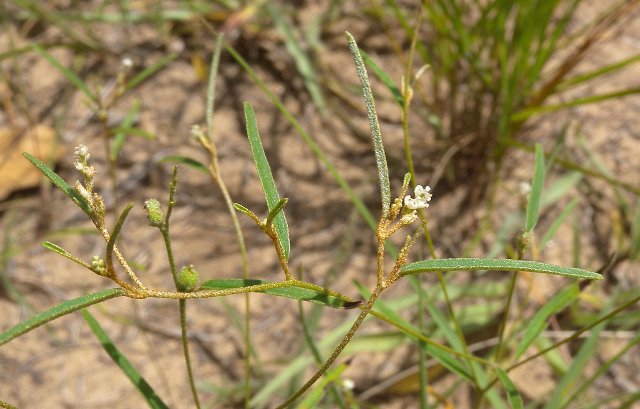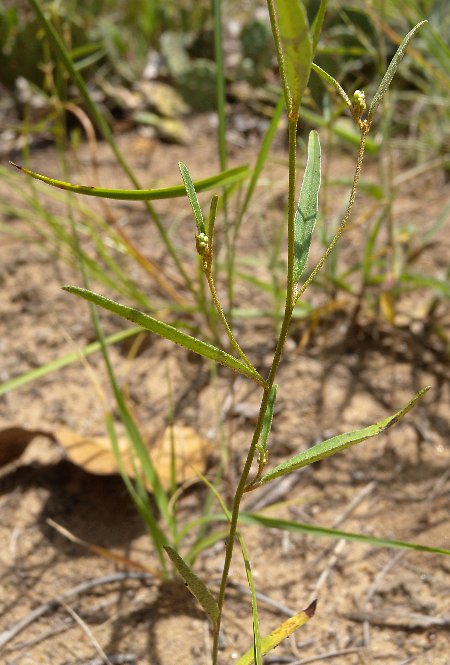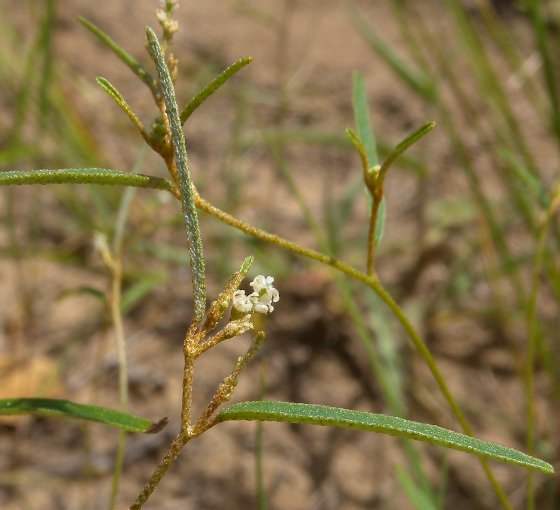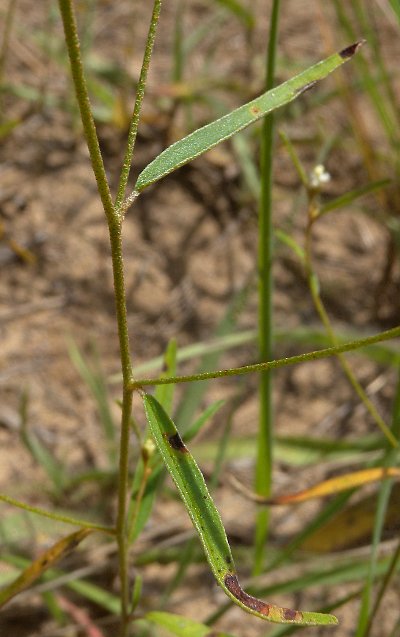Narrow-leaved
Rushfoil
Croton michauxii
Spurge family (Euphorbiaceae)
Croton michauxii
Spurge family (Euphorbiaceae)
Description:
This annual herbaceous plant is about 6–24" (15–60 cm.) tall, branching
occasionally. The lateral stems are mostly ascending. Individual stems
are terete and light green, although they are moderately to densely
covered with brown scale-like trichomes and stellate white hairs.
Spreading alternate leaves are produced sparingly along the stems.
Individual leaves are ¾–1½" (2–4 cm.) long and 1–4 mm. across; they are
oblong-linear in shape with toothless margins. There is a prominent
central vein on each leaf. The upper leaf surface is medium green and
sparsely covered with minute stellate hairs. The lower leaf surface is
light green and moderately covered with brown scale-like trichomes and
stellate white hairs. The slender petioles of the leaves are 1–5 mm.
long and moderately to densely covered with brown scale-like trichomes
and white stellate hairs. The trichomes produce glandular secretions.
Both axillary and terminal spike-like racemes occur on this monoecious
plant. These erect to ascending racemes are up to 1½" (4 cm.) long when
they are in full bloom.

About 1–6 pistillate (female) flowers occur along the lower one-half of each raceme, while 1–12 staminate (male) flowers occur along the upper one-half of each raceme. Individual pistillate flowers have a light green calyx with 4–5 lobes, a light green ovary that is globoid to ovoid in shape (becoming 2.5–3 mm. long at maturity), 3 styles that are slightly bifurcated at their tips, and no petals. The maturing ovaries are moderately covered with white stellate hairs and sparsely to moderately covered with brown scale-like trichomes. Individual staminate flowers (about 1–2 mm. across) have a light green calyx with 4-5 lobes, 5 white petals, and 4-6 white stamens with white anthers; the petals are narrowly oblanceolate in shape. The rachis (central stalk) of the raceme is similar in appearance to the stems. The blooming period occurs from mid-summer to early autumn, lasting about 2 months. Only a few flowers bloom at the same time. After the blooming period, the staminate flowers wither away, while the pistillate flowers are transformed into single-seeded fruits. The seeds are removed from their fruits by mechanical ejection. Individual seeds are 2–2.5 mm. long, ovoid or broadly ellipsoid in shape, slightly flattened, brown to black, and finely pebbly on the surface. The root system consists of a slender branching taproot. This plant reproduces by reseeding itself.

Cultivation: The preference is full or partial sun, dry-mesic to dry conditions, and somewhat acidic sandy soil. This plant has only a limited tolerance of other ground vegetation.
Range & Habitat: Narrow-leaved Rushfoil (Croton michauxii) is native to very sandy areas in central and northwest Illinois, where it is rare (see Distribution Map). This plant is more common in sandy areas of southeastern USA. In Illinois, habitats of this plant are restricted primarily to upland sandy savannas and sandy open woodlands where the dominant canopy trees are Quercus velutina (Black Oak) and/or Quercus marilandica (Blackjack Oak). In other states, it has been found in fields and along roadsides. However, Narrow-leaved Rushfoil is found in high quality natural areas in Illinois.

Faunal Associations: The nectar and pollen of the flowers attract primarily small Halictid bees (Lasioglossum spp.); see Moure & Hurd (1987). Some flies and smaller wasps may also visit the flowers. Such floral visitors are uncommon. Like other Croton spp., the foliage of Narrow-leaved Rushfoil (Croton michauxii) is eaten by a flea beetle (Syphrea nana) and the caterpillars of the Goatweed Butterfly (Anaea andria); see Clark et al. (2004) and Bouseman & Sternburg (2001). The Florida Harvester Ant (Pogonomyrmex badius) is apparently very attracted to the seeds of this plant as they have been found in considerable abundance in their nests in Florida (Tschinkel, 2017). This suggests that the seeds may have a coating or appendage that is attractive as a source of food to these ants, and they help to spread the seeds to new locations. The seeds are eaten by several species of birds, including the Mourning Dove, Lark Sparrow, White-crowned Sparrow, Brown-headed Cowbird, and Bobwhite Quail (Martin et al., 1951/1961). The foliage contains chemicals that can irritate the digestive tracts of cattle and possibly other mammalian herbivores.

Comments: Narrow-leaved Rushfoil has an unstable taxonomy in regards to its scientific name. It is currently referred to as Croton michauxii (Yatskievych, 2006), Croton michauxii michauxii (eFloras, 2018), and Crotonopsis linearis (Mohlenbrock, 2014). This plant is very similar to Elliptic-leaved Rushfoil, which has somewhat wider leaves and shorter floral racemes; this latter species occurs in southern Illinois in rocky sandstone areas, such as cliffs and glades. Elliptic-leaved Rushfoil is currently referred to as Croton willdenowii (Yatskievych, 2006), Croton michauxii elliptica (eFloras, 2018), and Crotonopsis elliptica (Mohlenbrock, 2014). Narrow-leaved Rushfoil and Elliptic-leaved Rushfoil were originally assigned to the Crotonopsis genus because of their one-seeded fruits, while Croton spp. usually have three-seeded fruits. But the latter genus has been recently expanded to include species with one-seeded, two-seeded, and three-seeded fruits by many authorities.

About 1–6 pistillate (female) flowers occur along the lower one-half of each raceme, while 1–12 staminate (male) flowers occur along the upper one-half of each raceme. Individual pistillate flowers have a light green calyx with 4–5 lobes, a light green ovary that is globoid to ovoid in shape (becoming 2.5–3 mm. long at maturity), 3 styles that are slightly bifurcated at their tips, and no petals. The maturing ovaries are moderately covered with white stellate hairs and sparsely to moderately covered with brown scale-like trichomes. Individual staminate flowers (about 1–2 mm. across) have a light green calyx with 4-5 lobes, 5 white petals, and 4-6 white stamens with white anthers; the petals are narrowly oblanceolate in shape. The rachis (central stalk) of the raceme is similar in appearance to the stems. The blooming period occurs from mid-summer to early autumn, lasting about 2 months. Only a few flowers bloom at the same time. After the blooming period, the staminate flowers wither away, while the pistillate flowers are transformed into single-seeded fruits. The seeds are removed from their fruits by mechanical ejection. Individual seeds are 2–2.5 mm. long, ovoid or broadly ellipsoid in shape, slightly flattened, brown to black, and finely pebbly on the surface. The root system consists of a slender branching taproot. This plant reproduces by reseeding itself.

Cultivation: The preference is full or partial sun, dry-mesic to dry conditions, and somewhat acidic sandy soil. This plant has only a limited tolerance of other ground vegetation.
Range & Habitat: Narrow-leaved Rushfoil (Croton michauxii) is native to very sandy areas in central and northwest Illinois, where it is rare (see Distribution Map). This plant is more common in sandy areas of southeastern USA. In Illinois, habitats of this plant are restricted primarily to upland sandy savannas and sandy open woodlands where the dominant canopy trees are Quercus velutina (Black Oak) and/or Quercus marilandica (Blackjack Oak). In other states, it has been found in fields and along roadsides. However, Narrow-leaved Rushfoil is found in high quality natural areas in Illinois.

Faunal Associations: The nectar and pollen of the flowers attract primarily small Halictid bees (Lasioglossum spp.); see Moure & Hurd (1987). Some flies and smaller wasps may also visit the flowers. Such floral visitors are uncommon. Like other Croton spp., the foliage of Narrow-leaved Rushfoil (Croton michauxii) is eaten by a flea beetle (Syphrea nana) and the caterpillars of the Goatweed Butterfly (Anaea andria); see Clark et al. (2004) and Bouseman & Sternburg (2001). The Florida Harvester Ant (Pogonomyrmex badius) is apparently very attracted to the seeds of this plant as they have been found in considerable abundance in their nests in Florida (Tschinkel, 2017). This suggests that the seeds may have a coating or appendage that is attractive as a source of food to these ants, and they help to spread the seeds to new locations. The seeds are eaten by several species of birds, including the Mourning Dove, Lark Sparrow, White-crowned Sparrow, Brown-headed Cowbird, and Bobwhite Quail (Martin et al., 1951/1961). The foliage contains chemicals that can irritate the digestive tracts of cattle and possibly other mammalian herbivores.

Comments: Narrow-leaved Rushfoil has an unstable taxonomy in regards to its scientific name. It is currently referred to as Croton michauxii (Yatskievych, 2006), Croton michauxii michauxii (eFloras, 2018), and Crotonopsis linearis (Mohlenbrock, 2014). This plant is very similar to Elliptic-leaved Rushfoil, which has somewhat wider leaves and shorter floral racemes; this latter species occurs in southern Illinois in rocky sandstone areas, such as cliffs and glades. Elliptic-leaved Rushfoil is currently referred to as Croton willdenowii (Yatskievych, 2006), Croton michauxii elliptica (eFloras, 2018), and Crotonopsis elliptica (Mohlenbrock, 2014). Narrow-leaved Rushfoil and Elliptic-leaved Rushfoil were originally assigned to the Crotonopsis genus because of their one-seeded fruits, while Croton spp. usually have three-seeded fruits. But the latter genus has been recently expanded to include species with one-seeded, two-seeded, and three-seeded fruits by many authorities.